Mayoor Mohan, Ph.D.

-Mayoor Mohan, Ph.D., Chapter 9 Author

INTRODUCTION
Markets are dynamic settings where various products and services compete for consumer attention. A closer examination of these offerings reveals that they result from meticulous planning, significant resource allocation, and strategic execution to reach the market successfully. Have you ever been using a product and stopped to wonder why it looks or works the way it does? Maybe you found an extra zipper on your ski jacket and didn’t know why it was added. Or perhaps, you were using a can opener and were puzzled at the way the handle was shaped. Every product we use is to a greater or lesser degree the result of a deliberate process where the company asks questions about how people like yourself will use and experience the product. This chapter delves into the process known as product development and management, which encompasses the journey of a product or service from conception to market and throughout its lifecycle. While we use the term ‘product’ for simplicity, it broadly includes both tangible products and intangible services.
The importance of product development and management to a company cannot be overstated. Executed effectively, it can leverage resources, bolster revenue, and enhance profitability. Profitability is crucial to this process, directly impacting a company’s financial health. The role of a product or service is equally vital in shaping a company’s image and reputation. A well-received product not only boosts the company’s profile but also contributes to long-term customer satisfaction and market share, highlighting the strategic importance of product development in a company’s quest for innovation and success. While product development doesn’t guarantee absolute success, it significantly increases the odds of favorable outcomes.
Indeed, innovation can take many forms, including product, process, business model, marketing, and organizational innovation (Kahn 2018). Each type showcases the broad spectrum of innovation in the business world. This chapter, aligning with the focus on product innovation, will explore how innovation is integral to effective product development, offering insights into how companies can leverage this process for sustained competitive advantage and growth.
PRODUCT, SERVICE, OR BOTH
In discussing marketplace offerings, we frequently interchange terms like ‘product,’ ‘service,’ and ‘program.’ Traditionally, products and services were seen as distinct, but today, they are frequently interconnected in the marketplace. For instance, consider the experience of purchasing a smartphone. The product component includes the physical device with features like the camera, screen, and processor. However, the overall experience also encompasses services such as customer support, software updates, warranty services, and perhaps a subscription to a cloud storage service. These service elements, combined with the physical device, constitute the whole experience of purchasing and owning a smartphone. Therefore, rigidly distinguishing between products and services may not capture the full scope of modern market offerings.
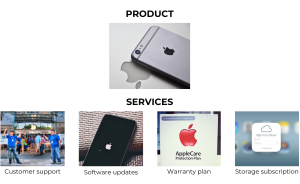
Given their interconnected nature, the development and management processes for both products and services share many similarities. In this chapter, we use the term ‘product’ for ease of reference, but it’s crucial to understand that ‘service’ elements are often integral to these offerings.
DEFINING A “PRODUCT?”
Recognizing the blended nature of goods and services, we need a broad definition of a ‘product.’ A product is any offering a company provides to its customers and can encompass various forms. This includes offerings that may not be directly consumed by the end user. For example, cloud computing services provided by companies like Amazon Web Services or Microsoft Azure to businesses are as much a product as a consumer electronic device like a Nintendo Switch. These services, essential in the B2B market, require as much strategic planning and management as traditional consumer products.
Indeed, depending on the context, the definition of ‘product’ may vary. For instance, it can be viewed as either a response to market demand or a reflection of a company’s internal perspective (Kahn & Mohan 2021). Let’s examine these perspectives below.
A MARKET-DEMAND DEFINITION OF PRODUCT
Products can be effectively defined from a market demand perspective, recognizing that all products originate from a core benefit and expand upon it. This can be visualized as a series of concentric circles, each representing a layer of product complexity and customer expectation, as shown in the visual below.
- Core Benefit: At the center is the core benefit, the essential element that fulfills a consumer’s basic need or want. For example, the core benefit of a smartphone might be communication.
- Generic Product: The next layer, the generic product, offers a basic, rudimentary version that delivers the core benefit. A basic mobile phone providing just voice and text services exemplifies this level.
- Expected Product: This level includes attributes and conditions that consumers typically expect. For a smartphone, this might consist of features like internet connectivity, camera functionality, and essential apps.
- Augmented Product: Here, additional services and benefits distinguish the offering from competitors. For smartphones, augmented features include advanced camera technology, unique apps, or exclusive AI-driven services.
- Potential Product: The potential product encompasses future augmentations and transformations. For the smartphone, this could involve integrating emerging technologies like augmented reality or advanced AI capabilities (assuming they don’t exist yet).
The Phone as an Outcome of Market Demand
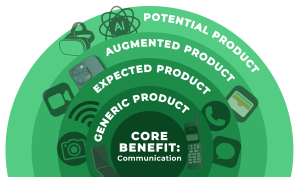
As products evolve from the core to the potential level, they typically transition from basic, cost-effective options to premium offerings with higher value and price points. This progression is crucial for companies in strategizing their product portfolios, balancing margin-oriented premium products with volume-driven basic offerings.
For instance, companies like Samsung and Apple offer smartphones across various levels, from basic models catering to essential communication needs to high-end devices with cutting-edge features. These diversified portfolios allow them to cater to multiple market segments.
In summary, defining a product by market demand involves understanding the layered nature of product offerings, from the fundamental core benefit to the expansive potential product. This approach highlights the importance of aligning product development with evolving consumer expectations and market trends.
A COMPANY’S INTERNAL DEFINITION OF PRODUCT
From an internal company viewpoint, defining a product involves understanding its categorization into product items, lines, families, and mixes.
- Product Item: This is the specific model, brand, or size of a product that a customer buys. For example, a Garmin Enduro 3 smartwatch with specific features like GPS, pulse oximeter, and solar charging is a product item.
- Product Line: Related product items are grouped into product lines based on shared characteristics, or target markets. For example, a tech company may have a product line of smartwatches varying in features and price points. If we continue looking at Garmin, they have options at lower price points with fewer features, like the vívofit 4, and more expensive options with a greater array of features, like the tactix 7 series.
- Product Family: These are broader categories that encompass related product lines, often organized to optimize manufacturing processes or marketing strategies. An example would be grouping all wearable technology, including smartwatches and fitness trackers, into a single product family. For Garmin, they categorize their wearable tech into categories like running watches, fitness tracking bands, golf watches, swimming watches, and so on.
- Product Mix: The highest level, the product mix, includes all product families a company offers. It’s characterized by width (number of product lines), depth (variety within each line), and consistency (how closely related the product lines are). Again, in Garmin’s case, this would include smartwatches, dash cams, car navigation systems, and fishfinders, to name a few.
Further, let’s take a company like Sony as an example. Sony’s product mix includes a wide range of electronics, from gaming consoles to cameras. Within each product line, like cameras, there are various models (depth) catering to different consumer needs, from amateurs to professionals. In contrast, a company like Tesla, known primarily for its electric vehicles, has a narrower product mix, focusing deeply on a specific market segment.
Issues like product proliferation and cannibalization are critical considerations in this framework. Product proliferation refers to the challenge of managing an extensive range of products, especially as the product mix widens (Danneels 2002). Cannibalization occurs when a new product negatively impacts the sales of existing products in the company’s portfolio. For example, a new model of an electric vehicle may cannibalize sales of an older model (Chandy & Tellis 1998). To manage these issues, companies must strategically assess their product mix, considering how new introductions align with existing offerings and market demands.
Understanding the internal perspective of product definition helps companies manage their portfolios effectively, avoid resource duplication, and identify opportunities for innovation and market expansion.
Overall, in the realm of product planning, the term ‘product’ covers a diverse range of offerings, reflecting the complex and integrated nature of contemporary markets. However, this compels us to appreciate what exactly it is that makes a product ‘new.’
WHAT MAKES A PRODUCT NEW?
The term ‘new product’ encompasses a range of innovations that vary in their level of novelty. Understanding these variations is critical to understanding how companies innovate and evolve in the marketplace. We can consider seven approaches to defining or characterizing a product as new along these lines, these include:
- Cost Reductions: Price changes or offering more cost-effective versions of existing products are common strategies companies adopt to expand their customer base. For instance, computer manufacturers often release affordable variants of their high-end laptops using less expensive components or omitting certain features. The primary aim of such a strategy is to make the product accessible to a broader audience while retaining the core functions.
- Product Improvements: Refer to the improvements made to a product’s form, function, or both. For example, an automotive company may release a new version of a car that has better fuel efficiency and improved safety features, replacing the previous model. These enhancements are frequently advertised as ‘new and improved’ to indicate they are better than older models.
- Line Extensions: Refer to the introduction of new variants to an existing product line. For instance, a beverage company may launch new flavors to the established line of drinks they offer. Unlike product improvements, the original product remains available, providing consumers with a wider range of choices within the same brand.
- New Markets: Involves the introduction of existing products to new geographic or demographic markets with minimal changes. A skincare brand, for example, might enter a new country’s market, slightly altering packaging to comply with local regulations or cultural preferences but keeping the product formulation the same.
- New Uses: Repositioning a product for new applications. A fabric softener brand might market its product as also being effective for refreshing upholstery, opening up an entirely new usage scenario for the same product.
- New Category Entries: A company may introduce products in a category that is new to them, but already familiar to consumers. For instance, a company specializing in kitchen appliances could expand into the personal care segment by offering hair dryers and straighteners. Although these products may be new to the company’s portfolio, they are already well-established among consumers.
- New-to-the-World Products: The products that represent radical innovations are the ones that create entirely new markets. Take, for instance, the first smartphone, which was a new-to-the-world product. It combined the functions of a mobile phone with that of a handheld computer, creating a new category that did not previously exist.
Types of New Products
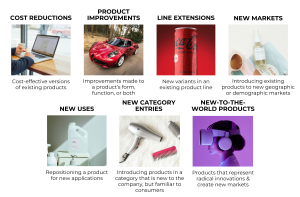
Companies often must manage multiple types of new products, adapting their strategies based on changing market trends, consumer needs, and technological advancements. For example, a tech company may be working on reducing the cost of a popular gadget, improving the features of another, and at the same time developing a revolutionary product that could create a new market niche.
Understanding the dynamics of product development and market evolution requires recognizing the diversity among ‘new products.’ Companies must balance refining existing offerings and pioneering groundbreaking products.
THE PRODUCT DEVELOPMENT PROCESS
A systematic and strategic approach to product development is crucial for success in modern business. This process typically involves several key stages, each serving a unique purpose and requiring specific actions and decisions. Such an approach is often called strategy-driven product development as it aligns the development process with the company’s strategic goals. For instance, consider Tesla’s foray into electric vehicles. The company’s strategy focused on sustainability and innovation. Every stage of their product development, from initial concept to final product launch, aligns with these strategic goals, ensuring that the vehicles they produce meet market demand and propel the company towards its long-term objectives.
STAGES IN THE PRODUCT DEVELOPMENT PROCESS
Typical stages in a strategy-driven product development process would include the following:
- Opportunity Identification: The first stage involves identifying potential market opportunities or unmet consumer needs. For example, Procter & Gamble conducts extensive market research to pinpoint gaps in consumer products, leading to the development of new offerings in their diverse product portfolio.
- Concept Generation: Here, potential product ideas are brainstormed and gathered. A company like 3M, known for its culture of innovation, encourages employees to develop a wide range of ideas, leading to diverse products from Post-it Notes to medical supplies, like stethoscopes.
- Pre technical Evaluation: In this stage, the feasibility of product concepts is assessed. Amazon, for instance, uses a unique approach where hypothetical press releases are created for potential products to evaluate their market appeal and feasibility.
- Technical Development: This stage involves developing and testing the product to ensure it meets technical and consumer standards. Apple’s development of the iPhone is a prime example, where numerous prototypes were tested to refine the product before its highly successful launch.
- Launch: This stage comprises final preparations and the actual introduction of the product to the market. An example is the launch of Microsoft’s Xbox gaming console, which involved extensive marketing and partnership strategies to ensure its acceptance in the highly competitive gaming market.
- Life Cycle Management: Post-launch, the product is continuously managed and adapted based on market feedback and changing consumer needs. Samsung’s iterative improvements to its Galaxy smartphone series illustrate this ongoing process of enhancement and adaptation.
The Strategy-Driven Product Development Process
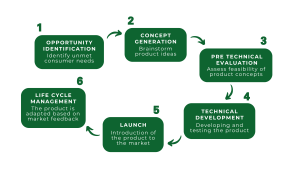
PRODUCT LIFE CYCLE MANAGEMENT
After a product’s launch, it enters the crucial phase of ‘life cycle management.’ This phase is typically overseen by a product management team, which takes over from the product development team. Their primary focus is on maximizing the product’s potential within the company’s product mix, fine-tuning marketing strategies, countering competitive threats, and fostering continuous innovation.
THE PRODUCT LIFE CYCLE CONCEPT
The product life cycle (PLC) concept describes a product’s sales progression from launch to withdrawal. It’s often represented by a curve, paralleling the product’s diffusion in the market (see the sales curve below). This life cycle is divided into four stages: introduction, growth, maturity, and decline (Levitt 1965).
- Introduction Stage: This initial stage involves building awareness and encouraging trial. Sales growth is typically slow as the market is being established. An example is the early days of Netflix’s streaming service, where the focus was on building awareness and a robust subscriber base.
- Growth Stage: Characterized by rapid sales increase, this stage focuses on maximizing market share. A classic example is the rapid expansion of smartphone use globally, with companies like Apple and Samsung aggressively capturing market share.
- Maturity Stage: Sales level off as the product reaches peak market penetration. The focus shifts to maintaining market share and maximizing profit. Coca-Cola in the soft drink market is an example of a product in the maturity stage.
- Decline Stage: The final phase where sales and market interest wane. Strategies often involve cost-cutting or pivoting to new markets. For instance, traditional print newspapers have experienced a decline stage due to the rise of digital news consumption.
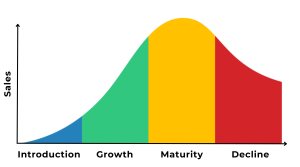
NAVIGATING FUTURE TRENDS AND PRACTICAL APPLICATIONS IN PRODUCT DEVELOPMENT AND MANAGEMENT
Recognizing the dynamic landscape of industry trends and their implications on future product strategies is crucial. Emerging technologies, evolving consumer behaviors, and increasing emphasis on sustainability are reshaping how products are developed and managed. Let’s delve into some of these trends that are shaping contemporary product development and management.
EMERGING INDUSTRY TRENDS
- Artificial Intelligence (AI) and Machine Learning (ML): AI and ML are revolutionizing product development, offering unprecedented insights into consumer behavior, optimizing manufacturing processes, and enhancing product personalization. For instance, AI-driven analytics can predict market trends, enabling companies to adjust their product strategies proactively.
- Sustainability and eco-friendly products: There’s a growing consumer demand for sustainable and environmentally friendly products. Companies are responding by integrating sustainable practices throughout the product life cycle, from sourcing eco-friendly materials to ensuring products are recyclable or biodegradable.
- Digital transformation and IoT (Internet of Things): The integration of digital technology into all areas of business is altering how products are designed, manufactured, and serviced. IoT, in particular, is leading to the development of smart, connected products that offer enhanced customer experiences.
- Customization and personalization: With advancements in technology, the ability to offer customized and personalized products is becoming a significant competitive advantage. This trend is particularly evident in industries like fashion and consumer electronics, where products are increasingly tailored to individual preferences.
SUMMARY
As we conclude our exploration of product development and management, it’s evident that this field is both dynamic and multifaceted, requiring a keen understanding of market trends, consumer behavior, and technological advancements. The journey through various strategies, from the foundational concepts of product planning to the intricate details of life cycle management and the innovative approaches of industry leaders like Tesla and Nike, underscores the complexity and excitement inherent in bringing a product from concept to market. As future marketers and product developers, students are encouraged to embrace these challenges with creativity, strategic thinking, and an unwavering commitment to innovation and sustainability. The lessons learned from this chapter not only provide a solid foundation in product development theory but also inspire a forward-looking perspective, essential for navigating the ever-evolving landscape of global markets and consumer needs.
REFERENCES
Chandy, R. K., & Tellis, G. J. Organizing for radical product innovation: The overlooked role of willingness to cannibalize. Journal of Marketing Research, 35(4), 474–487. 1998.
Danneels, E. The dynamics of product innovation and firm competencies. Strategic Management Journal, 23(1), 1–21. 2002.
Kahn, K. B. Understanding innovation. Business Horizons, 61(3), 453–460. 2018.
Kahn, K. B., & Mohan, M. Innovation and new product planning. Routledge. 2021.
Levitt, T. Exploit the product life cycle. Harvard Business Review, 43(6), 81–94. 1965.
Media Attributions
- 8
- iPhone via pxhere, licensed under CC0 Public Domain. Opening day by Katie Haugland Bowen, licensed under CC BY 2.0. iPhone Update via Wallpaper Flare, licensed under CC0 Public Domain. Apple Care by Compudemano, licensed under CC BY 2.0. iCloud by iphonedigital, licensed under CC BY-SA 2.0.
- Fig. by Z. Farley
- Images in chart all licensed under Pexels license
- Fig. by Z. Farley
- Graph by Z. Farley
Any offering a company provides to its customers and can encompass various forms
The essential element that fulfills a consumer's basic need or want
A basic, rudimentary version of a product that delivers the core benefit
A product which includes attributes and conditions that consumers typically expect
A product with additional services and benefits to distinguish the offering from competitors
Encompasses future augmentations and transformations.
The specific model, brand, or size of a product that a customer buys
Related product items are grouped into product lines based on shared characteristics, or target markets
Broader categories that encompass related product lines, often organized to optimize manufacturing processes or marketing strategies
Includes all product families a company offers
The challenge of managing an extensive range of products, especially as the product mix widens
Occurs when a new product negatively impacts the sales of existing products in the company's portfolio
Price changes or offering more cost-effective versions of existing products are common strategies companies adopt to expand their customer base
The improvements made to a product's form, function, or both
The introduction of new variants to an existing product line
The introduction of existing products to new geographic or demographic markets with minimal changes
Repositioning a product for new applications
Products in a category that are new to the company releasing them, but already familiar to consumers
Products that represent radical innovations are the ones that create entirely new markets
The first stage of the strategy driven product development process. This stage involves identifying potential market opportunities or unmet consumer needs
The second stage of the strategy driven product development process. In this stage, potential product ideas are brainstormed and gathered
The third stage of the strategy driven product development process. In this stage, the feasibility of product concepts is assessed
The fourth stage of the strategy driven product development process. This stage involves developing and testing the product to ensure it meets technical and consumer standards
The fifth stage of the strategy driven product development process. This stage comprises final preparations and the actual introduction of the product to the market
The sixth and final stage of the strategy driven product development process. In this stage, the product is continuously managed and adapted based on market feedback and changing consumer needs
Describes a product’s sales progression from launch to withdrawal
The first stage of the product life cycle. This stage involves building awareness and encouraging trial, and sales growth is typically slow as the market is being established
The second stage of the product life cycle. This stage focuses on maximizing market share and is characterized by rapid sales increase
The third stage of the product life cycle. This stage is when sales level off as the product reaches peak market penetration, and the focus shifts to maintaining market share and maximizing profit
The fourth and final stage of the product life cycle. This phase is where sales and market interest wane, and strategies often involve cost-cutting or pivoting to new markets
